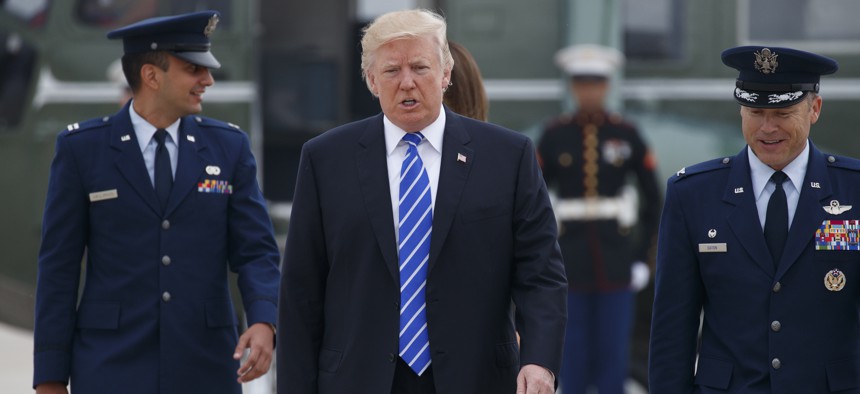
President Donald Trump walks to board Air Force One for a trip to Poland and Germany, Wednesday, July 5, 2017. AP Photo/Evan Vucci
How Poland Sets Trump Up for Success With Putin
Trump’s Poland visit could give the American president a strong message – and momentum – for his Putin meeting later this week.
All eyes are focused on President Donald Trump’s planned meeting with Russian President Vladimir Putin at the G-20 later this week in Germany. But Trump’s first stop is Poland and his visit with President Andrzej Duda will likely set the tone for the balance of the trip.
Trump’s last visit to Europe in May was not particularly well received by many Europeans. This time, Americans are watching to see if Trump can warm transatlantic relations and be firm in his discussion with Putin. Russians and Europeans, however, a bit more closely will watch Trump’s Poland stop, as it carries great sensitivities.
Though he is not a student of history, Trump would be wise to recognize that Poland is a young democracy with a lengthy history of political and social upheaval. While the country has left the days of the Cold War far behind, Poles are still uncertain how exactly they fit into modern day Europe, as the government’s recent European Union skepticism indicates. But Poland also remains supremely distrustful of Russia and is highly reliant on NATO for it’s security — especially the United States. Poland is very aware of its security vulnerabilities and fortunately is making strides to mitigate them, as illustrated in its recently published Polish Defense Concept paper.
Look for Trump to focus his Poland visit on several key topics to ensure that the stop is a success.
First, to ensure both a strong U.S.-Polish bilateral defense relationship and a positive U.S.-NATO relationship, Trump must address his missteps pertaining to NATO’s Article 5, which commits NATO members to mutual defense. With Poland’s deep reliance and belief in NATO and Article 5 in particular, Warsaw is the perfect place for such reassurances to be made. While the White House may believe its support for Article 5 is unambiguous, many NATO allies are far less certain. Trump finally clearly enunciated support for Article 5 at a June 9 White House press conference with Romanian President Klaus Iohannis, but he can and should say more. By reaffirming America’s commitment to NATO and Article 5 on foreign soil, particularly soil that was once occupied by the Soviet Union, Trump can put the issue to rest. He would echo Congress’s recent, near unanimous votes confirming Washington’s commitment to NATO and mutual defense among allies.
Second, Trump should encourage Poland to continue increasing defense spending – but he should do it thoughtfully. Many administration officials are casting the president’s trip as a reward for Poland meeting NATO’s nonbinding goal for each member to spend 2 percent of their GDP on defense, having already proclaimed this achievement is due to the new president’s “scolding.” Seeking credit for decisions Poland made several years ago will only undercut Trump’s credibility on the subject. In reality, Poland reached the 2 percent benchmark officially in 2015 as it ramped up spending in response to both Russia’s partial occupation of Ukraine and NATO’s 2014 Wales Summit defense spending agreement. Poland has further plans to achieve 2.2 percent by 2020 and 2.5 percent by 2030. Hence, Trump would be wise to note his support for the 2 percent threshold is a continuation of policies endorsed by successive Democrat and Republican presidential administrations, not to mention NATO’s own defense planners.
Third, Trump ought to take the opportunity to give Poland some “tough love,” particularly on air and missile defense. Discussions among Poland, the U.S., and defense industry suppliers on acquiring an air defense system have gone on for years with no agreement. Polish officials need to get serious and reach a deal. The threat to Poland’s skies has become more serious. The country needs adequate air defenses, particularly given recent increased deployments of U.S. and allied forces to the country.
Finally, as a relatively new democracy, Poland has made missteps but America’s president should be clear about what it, and its allies, should stand for. Polish leaders have undermined the constitutional court, enabled government attempts to control media outlets, and defunded or overly-regulated nongovernmental organizations that are perceived to be “unfriendly” to the government. Though Trump, in his May speech in Saudi Arabia, said that he was not interested in “lecturing” or “telling other people how to live [or] what to do,” he should take the opportunity to use some blunt words to encourage Poland not to backslide on democratic principles and personal freedom. Rather, Trump should highlight the U.S. troop presence in Poland and note that these soldiers are there to fight for freedom and democracy and they deserve a partner country in Poland that stands for the same principles.
If in the course of his visit Trump can achieve these goals, he will have taken steps to repair transatlantic relations, improved U.S., Polish and NATO security, and delivered the message that Poland’s government must not trample on the very democracy Poles have worked so hard to build since launching the Solidarity movement in 1980. That’s a strong message with momentum the American president could take into his meeting with Putin.



